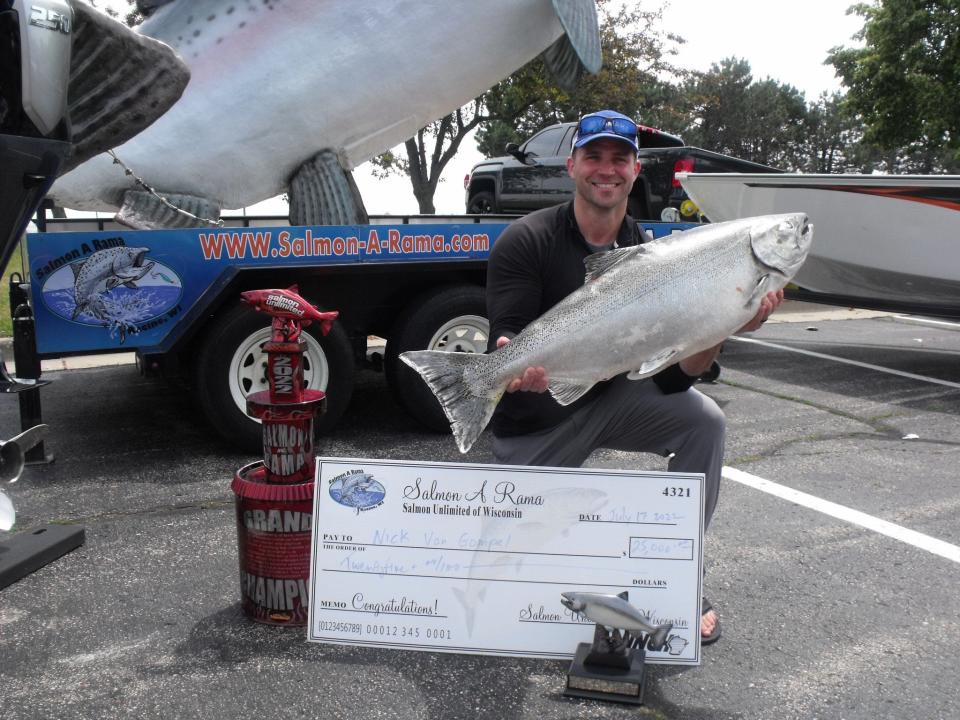DNR increases Lake Michigan chinook stocking goal for 2023

The Wisconsin waters of Lake Michigan will be stocked with more chinook salmon in 2023 but all other salmon and trout species will be unchanged, according to a plan recently announced by the Department of Natural Resources.
This year's DNR Lake Michigan stocking goals are 1.3 million chinook salmon, up from 1.2 million in 2020-22, as well as 500,000 coho salmon, 460,000 steelhead, 450,000 brown trout and 50,000 brook trout, the same levels as in the previous plan.
The five species are raised in state fish hatcheries and stocked by DNR staff, sometimes (as with most chinook salmon) in partnership with local clubs that help maintain net pens at sites along Lake Michigan.
The pens are designed to help the hatchery fish acclimate to and imprint on their new home water as well as reduce the amount of predation from birds and other fish at the stocking sites.
In addition to the state-raised fish, 45,000 lake trout will be reared and stocked in 2023 in the Wisconsin waters of Lake Michigan by the U.S. Fish and Wildlife Service.
This year's lake trout goal is unchanged from 2020-22 but is a dramatic decrease from the 296,778 lakers stocked in 2019 and the yearly average of 621,930 stocked from 2010-19.
At the urging of the charter fishing lobby and some sport anglers, the DNR in 2017 began reducing the stocking of lake trout and brown trout to prevent cuts in chinook plants.
Slight rebound in forage base leads to chinook stocking increase
The Lake Michigan Committee, a regional fisheries management panel, in 2016 recommended a 62% reduction in chinook stocking. While other states reduced chinook plants, the Wisconsin DNR kept chinook stocking constant but cut lakers and browns.
Recent data from Lake Michigan show the forage base remains low in historical terms but has rebounded slightly in recent years and fisheries managers are moving ahead with salmon stocking increases.
Bob Wincek of New Berlin, president of the Wisconsin Federation of Great Lakes Sport Fishing Clubs, supported the DNR's plan for 2023.
"We see it as being careful and responsible," Wincek said. "There's only so much bait out there. We're happy with the numbers for now and are cautiously optimistic for the outlook on the whole lake."
Michigan, Indiana are also increasing their chinook stocking goals
In addition to the Wisconsin decision, officials in Michigan and Indiana also announced chinook stocking increases in recent months.
Michigan is increasing its chinook stocking goal from 650,000 in 2022 to 1 million in 2023, while Indiana is nudging its plan up from 225,000 last year to 275,000.
A 2022 run of a predator-prey model suggests Lake Michigan has a good ratio of chinook salmon to alewife biomass, one of many indicators used to inform stocking decisions, according to Jay Wesley, Lake Michigan basin coordinator for the Michigan DNR.
About 60% of the chinook in the lake are wild fish spawned naturally in rivers on the Michigan side of the lake or in Lake Huron tributaries.
Wesley characterized the Michigan chinook stocking increase as "modest" compared to the estimated 4.5 million wild chinook in the lake.
Ben Dickinson, Lake Michigan biologist for the Indiana DNR, said the improved predator-prey balance in the lake allows for the increase, which should benefit anglers, but biologists will be monitoring the need for future adjustments.
“Anglers should realize increasing stocking does increase predation pressure and may increase future risk to baitfish populations,” Dickinson said. “We will continue to closely watch the predator-prey balance to help ensure the long-term health of the fishery.”
The Wisconsin DNR is working to develop a 2024-26 Lake Michigan stocking plan. Fisheries staff will be evaluating data, including the 2022 forage assessment and 2022 chinook harvest levels, to develop stocking levels for the next three years.
The DNR plans to hold public meetings this summer and have a 2024-26 stocking plan by Oct. 1.
Our subscribers make this reporting possible. Please consider supporting local journalism by subscribing to the Journal Sentinel at jsonline.com/deal.
DOWNLOAD THE APP: Get the latest news, sports and more
This article originally appeared on Milwaukee Journal Sentinel: The Wisconsin waters of Lake Michigan will receive 1.3 million chinook

